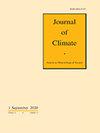MJO-induced Warm Pool Eastward Extension Prior to the Onset of El Niño: Observations from 1998-2019
IF 4.8
2区 地球科学
Q1 METEOROLOGY & ATMOSPHERIC SCIENCES
引用次数: 0
Abstract
Abstract The Madden-Julian Oscillation (MJO) and El Niño Southern Oscillation (ENSO) are the two most important tropical phenomena that affect global weather and climate on intraseasonal and interannual timescales. Although they occur on different timescales, the MJO-induced sea surface temperature (SST) anomalies over the equatorial Pacific have spatial scales similar to SST anomalies prior to El Niño. This study aims to address the question of whether the MJO plays an important role in the warm pool eastward extension (WPEE) leading up to El Niño. We use over 20 years of satellite observations, including optimum interpolated SST, TRMM-GPM precipitation, and the cross-calibrated multi-platform (CCMP) surface winds from 1998-2019, to quantify the spatial structure and duration of the MJO-induced warm SST anomalies over the equatorial Pacific (130°E-180°E, 10°S–10°N). The intensity of the MJO is measured by the total rain volume and average surface westerly wind speed throughout its convectively active phase. Results show that 1) 61% of the MJO events induced a WPEE over 1000-3000 km along the equator, which can last beyond 15 days; 2) the MJO events prior to El Niño are generally stronger and produce significant WPEE far beyond its annual cycle and increasing SST warming in the Niño 3.4 region; 3) consecutive MJO events can produce much stronger WPEE prior to El Niño, which are observed in all El Niño events from 1998-2019; and 4) more frequent and stronger MJO-induced WPEE occur in March-May than other seasons. These results can help better understand the MJO-ENSO interaction and, ultimately, improve the prediction of El Niño onset.厄尔尼诺Niño开始前mjo引起的暖池向东延伸:1998-2019年的观测
麦登-朱利安涛动(MJO)和厄尔Niño南方涛动(ENSO)是在季节内和年际时间尺度上影响全球天气和气候的两个最重要的热带现象。mjo引起的赤道太平洋海温异常虽然发生在不同的时间尺度上,但其空间尺度与El Niño之前的海温异常相似。本研究旨在探讨MJO是否在暖池东扩(WPEE)过程中发挥了重要作用,从而导致El Niño。利用1998-2019年20多年的卫星观测数据,包括最适插值海温、TRMM-GPM降水和交叉校准多平台(CCMP)地面风,量化了赤道太平洋(130°E-180°E, 10°S-10°N) mho引起的温暖海温异常的空间结构和持续时间。MJO的强度是通过整个对流活动性阶段的总降雨量和平均地面西风风速来测量的。结果表明:1)61%的MJO事件在赤道沿线1000 ~ 3000 km范围内诱发WPEE,持续时间超过15 d;2) El Niño之前的MJO事件普遍较强,并在Niño 3.4区域产生远超其年循环的显著WPEE,海温升温加剧;3)连续MJO事件可在El Niño之前产生更强的WPEE, 1998-2019年所有El Niño事件都有这种现象;4) 3 - 5月mjo引起的WPEE比其他季节更频繁和强烈。这些结果可以帮助更好地理解MJO-ENSO相互作用,并最终提高对El Niño发病的预测。
本文章由计算机程序翻译,如有差异,请以英文原文为准。
求助全文
约1分钟内获得全文
求助全文
来源期刊

Journal of Climate
地学-气象与大气科学
CiteScore
9.30
自引率
14.30%
发文量
490
审稿时长
7.5 months
期刊介绍:
The Journal of Climate (JCLI) (ISSN: 0894-8755; eISSN: 1520-0442) publishes research that advances basic understanding of the dynamics and physics of the climate system on large spatial scales, including variability of the atmosphere, oceans, land surface, and cryosphere; past, present, and projected future changes in the climate system; and climate simulation and prediction.
 求助内容:
求助内容: 应助结果提醒方式:
应助结果提醒方式:


